Early in the epidemic of hysteria spawned by the fire ant’s arrival in the USA was the claim that this Ant from Hell would totally overwhelm every square meter of Dixie, that their population would increase unchecked unless the USDA intervened with its three (ultimately failed) Wars on Fire Ants. A small example of this belief occurs every time someone asks me, “Well, if I don’t do something, won’t they take over my whole yard?”
The answer to that question is Yes and No. If the questioner means, “Am I going to see a yard covered with fire ant mounds, like a bad case of acne or hair on a dog’s back,” the answer is No. If the questioner means, “Will fire ant workers be present in my whole yard”, the answer is more or less Yes (unless you live in a deep forest, in which case, you won’t have any fire ants).
The simple truth is that fire ant populations are self-limiting because colonies are territorial, meaning that each colony defends a plot of land against intrusion by its neighbors. As with all territorial animals, only so many territories can fit on any piece of land. Yes, territories can be compressed as the population and competition increase, but there is a limit beyond which they cannot be compressed further, and contenders are left without territory and thus little chance to reproduce. Thus, no matter what the animal, territoriality regulates animal populations.
The male Carolina wren in our yard flies from place to place within his territory, singing his heart out to advertise that he stands ready to fight any intruding male Carolina wrens. But a fire ant colony resides in a semi-permanent mound, unable to flit about its territory. How does it defend its territory? The answer is that in contrast to the unitary wren, the colony consists of up to a quarter million workers that form an organism-like entity, a so-called superorganism. Effectively, the colony is an organism whose parts (the workers, brood and queen) are not physically connected to each other. Therefore, it can blanket its territory with foraging workers searching for “vittles” (as we say in the South), and when some of these foragers move outward far enough, they are likely to meet workers from a neighboring colony (or just get bored and turn back). Upon contact, smell identifies the neighbor ant as a stranger and not a sister. They may fight, but their most likely response is to turn and run back, creating a zone in which fire ants are scarce.
The location of this zone depends on the relative forager density of the neighbors. Even if their walks are random, foragers will move outward from a higher density into a lower density neighbor area (like an expanding gas), and when they do, those from the higher density are less likely to contact a neighbor than the other way around. There will thus be fewer reverse runs and more advances in the higher density territory, causing the boundary contact zone to move toward the lower density colony, thereby compressing that territory and increasing its density until the two densities are equal. At that point, the boundary becomes stable. The boundary is thus dynamic and depends on the rate of contact between foragers from neighbor colonies.
Can we find the location of these boundaries? This turns out to be easy and fun and doesn’t take much equipment. Put little bits of Spam or tuna in each of several dozen small test tubes, place three or four directly on the focal nest mound and arrange the others a meter or so apart on spokes running outward from the mound. After 15 minutes or more, fire ants will have found and occupied most of the tubes. Then we pick up one of the tubes on the mound (wear vinyl gloves!) and bring it mouth to mouth with the first tube on one of the spokes. If both tubes contain ants from the focal colony, the workers will mix amicably. Now bring this first spoke tube together with the next spoke tube. Again, same colony, peace reigns. But eventually, the workers in the next tube will be from a neighbor colony, and when they are, the workers attack one another vigorously. The boundary lies between these two tube locations.
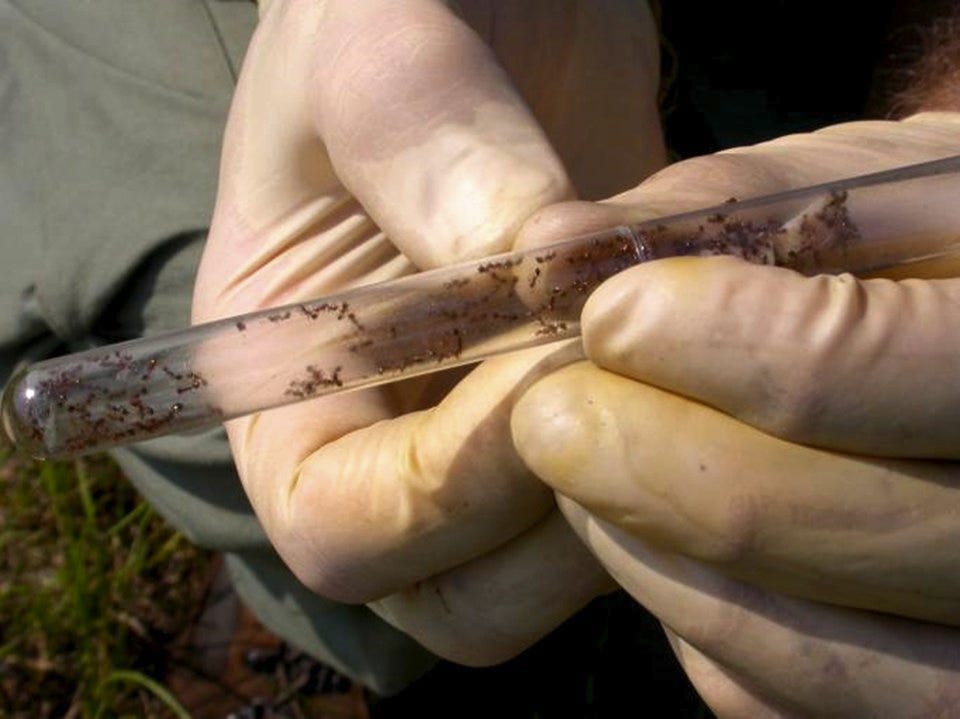
We repeat this procedure for all the spokes, map the locations of the last “peaceful” tube and the first “attack” tube, connect all these points, and we have a map of the territory of the focal colony. It takes one to three hours to carry out this full procedure. You can try to find the boundary with greater precision by putting baits between the last and first tubes, but often, few ants appear on baits in this boundary zone because it is a “no-ants-land” formed by mutual avoidance.
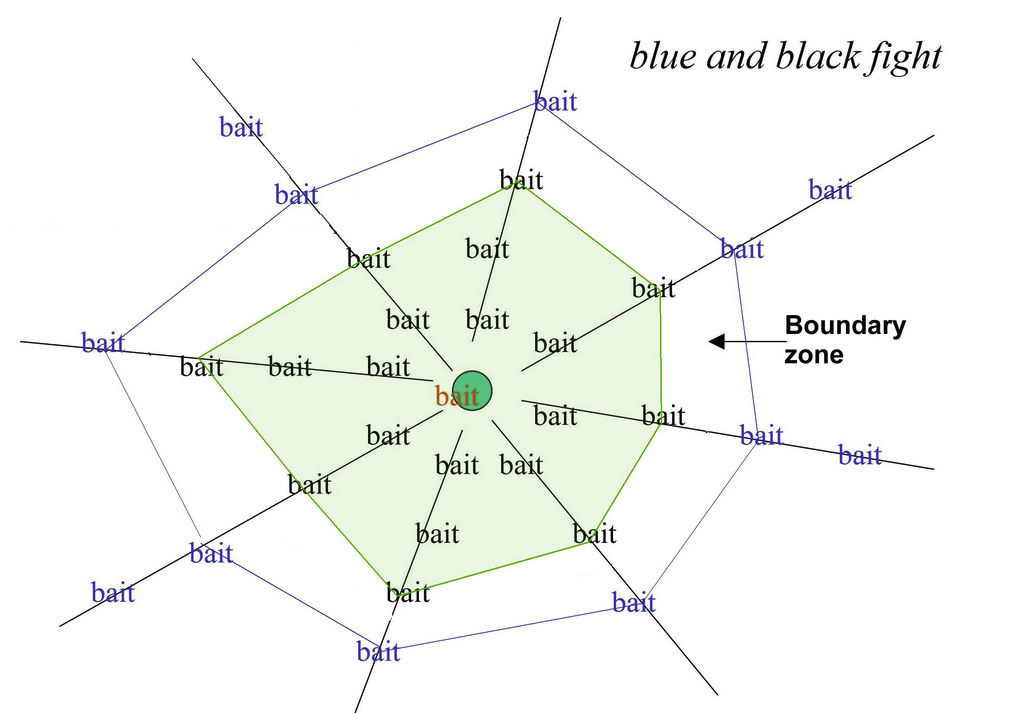
Not surprisingly, larger colonies have larger territories. A mature colony often controls an area equal to that of an average house (below). The white tape shows the last baits occupied by the focal colony, and the red tape the first bait occupied by neighbors. The space between these is the no-ants-land. The territory is the source of all the colony’s resources, the space that gives it life, and without which it cannot exist.
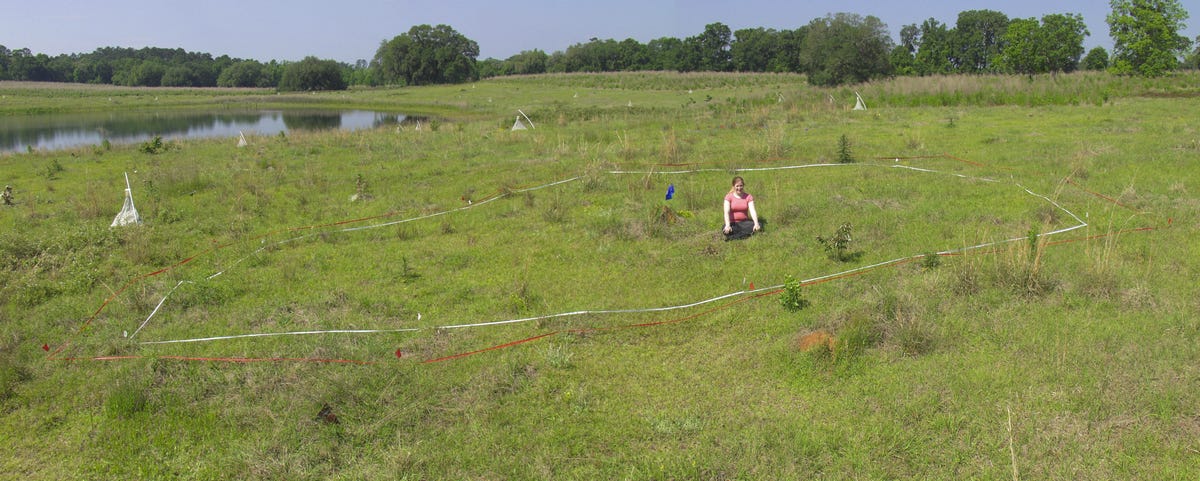
A prolonged drought during our study inadvertently provided support for the dynamic nature of border formation--- during the drought, the outermost baits often remained unoccupied giving rise to a huge no-ants-land (left image below), showing that under such dehydrating conditions the foragers did not go as far from their nests and were thus not encountering neighbors. Immediately after the next rain, foragers from all colonies traveled farther from the nest, encountered neighbors, and established a dynamic border again. In the right image, the territory gained by the focal colony is shown in green, and that gained by neighbors is red. The new no-ants-land was much narrower than it was during the drought.
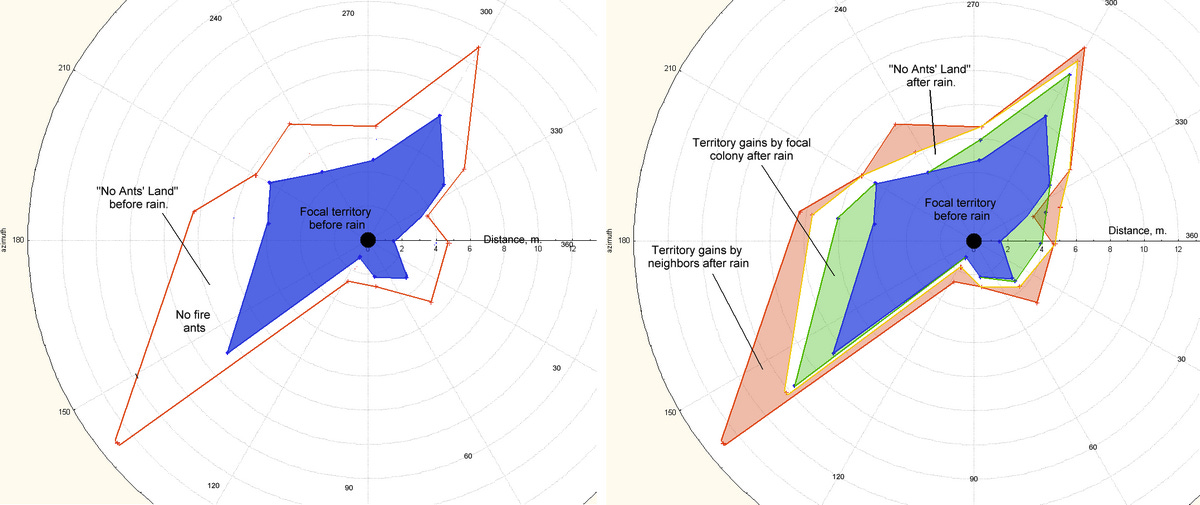
Such dynamic border formation predicts that the nest mound ought to be near the center of the territory as foragers spread out in all directions. And indeed, it often is, as in the left example below. But many times, the nest mound is far from the center, as on the right below. Although borders are remarkably stable, they do shift over longer times until the nest is no longer in the center, as below. Non-central nests are more likely to relocate, and when they do, they eventually move closer to the territory center (open red circles). Because each colony is surrounded by the territories of hostile colonies, it can only move within its own territory.
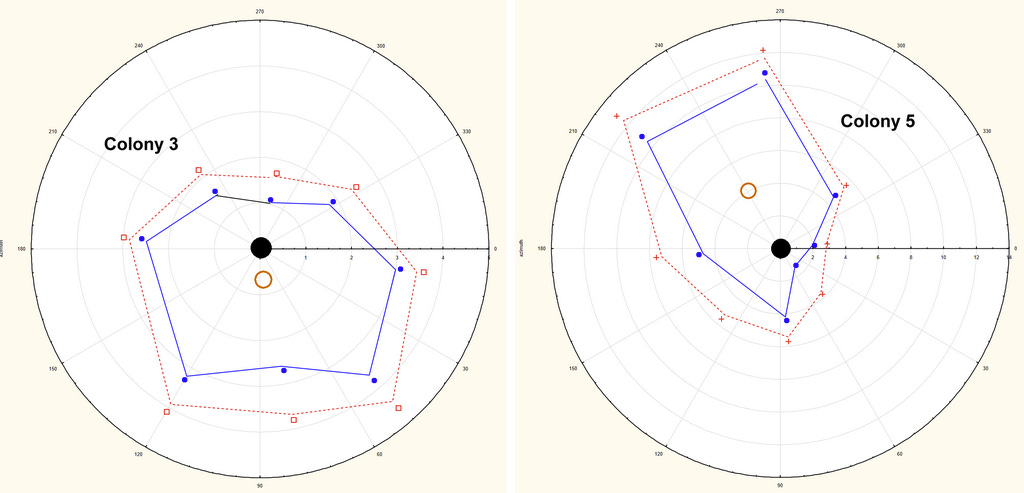
Because colonies get all their resources from their territory, for a colony to grow larger, it must acquire more territory. But how can it do that when all its neighbors are doing the same thing. This invisible competition for space must be intense. We may look at a pasture occupied by fire ant colonies, dotted here and there with nest mounds (top image below), but the reality for the fire ants is shown in the bottom image--- a mosaic of territories that completely covers the land, some of them large, some tiny and wedged between big bullies. How can small colonies make headway against the big ones?
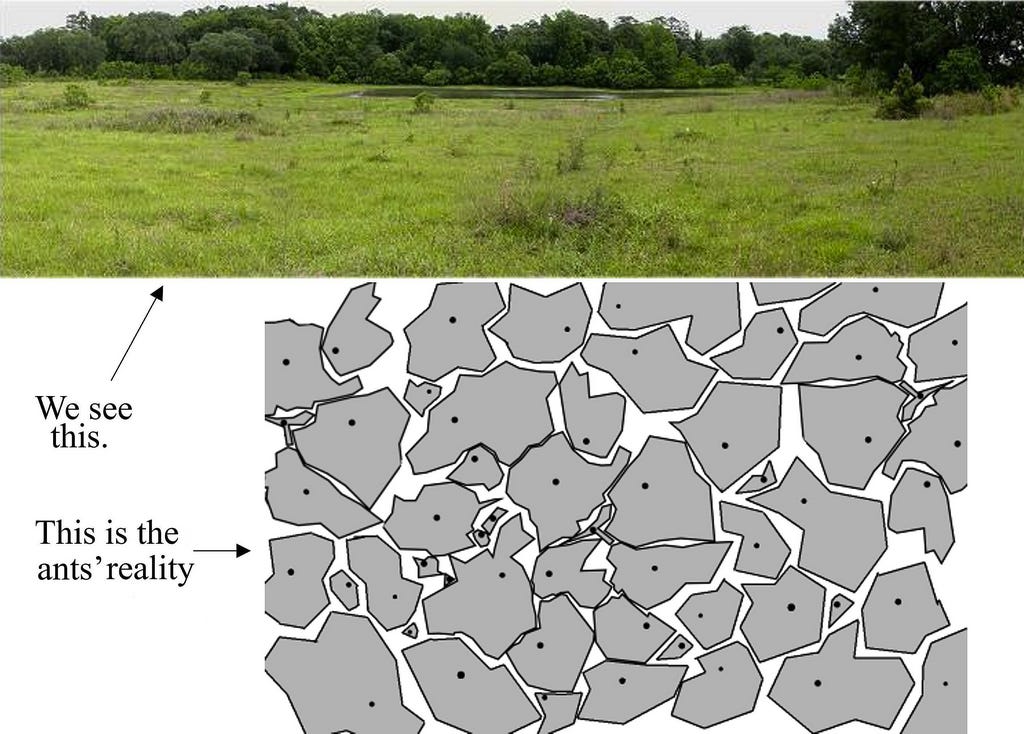
The answer probably lies in their relative “military expenditure.” Recall that the boundaries shift until forager density is similar for both colonies. Thus, colonies that field a higher density of foragers should gain territory at the expense of these that field lower densities. Can we test this by estimating relevant forager densities? Yes, all we need is a battery-powered shop vacuum to suck up any workers moving about in small sample areas, then counting the number captured. Given the heat and humidity of Florida summers, counts are best done in the shade after dumping the take into a tray.
And indeed, small colonies typically field a higher density of foragers than large ones. This is because in the spring, large colonies shunt a large part of their productive capacity into winged sexual males and females as part of colony reproduction, while small colonies invest all their production into workers and colony growth. Think of this as the wages of sin and virtue, respectively, a trade-off between sex and growth. This trade-off plays out over the annual cycle, allowing small colonies to gain territory during every spring when large colonies are busy with sexual reproduction. Over multiple years in the mosaic above, large colonies will grow smaller, and small ones larger. The price of sex is paid in the currency of territory area.
Such differences in forager density were visible in our vacuum samples (below). The large colony had an area of about 33 square meters and a perimeter of 22 meters, whereas the small colony area was only 7 square meters, and its perimeter 13 meters. Forager densities within the large territory (left) were mostly less than a hundred, while in the small one, six out of eight were well over 100. The small colony thus had several times the forager density per meter of perimeter boundary than the large one, and thus could exert more outward “pressure” to gain space and resources.
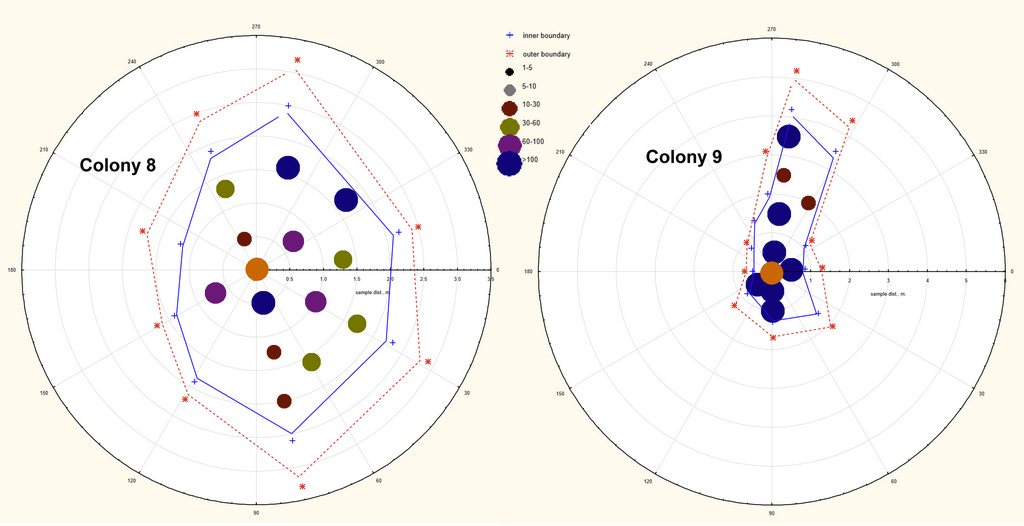
Territory is central to the life history of the fire ant. Because habitat is so variable, surely some locations are more beneficial than others. As in everything, chance dominates the lives of fire ants right from the start. Chance determines whether a female sexual departing on her mating flight will mate with a well-matched male (or at all), whether she will escape becoming a snack for birds or dragonflies, whether she will land in a spot not already occupied by a fire ant colony, whether she will survive the very stressful founding period, and whether the young colony finds itself in favorable habitat. In a fully occupied habitat such as the one I worked in, the only hope for successful founding is to land by chance in a no-ant-zone and thus to escape being killed by established fire ants. Although this is the stuff for another essay, of the mated queens that even try to establish a colony (already a small fraction of those that left their natal nest to mate), only about 0.1% will be alive in a year. In a stable fire ant population, only one of the 9000 female sexuals produced in the average colony’s lifetime of seven to eight years is still alive after three years, and only one will survive to replace her parent colony. Fire ants remind us of what it takes for a creature to persist. Life certainly ain’t easy for a queen named Sue.
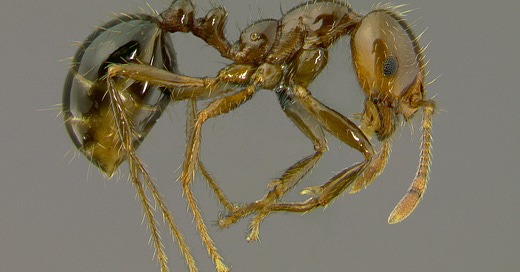



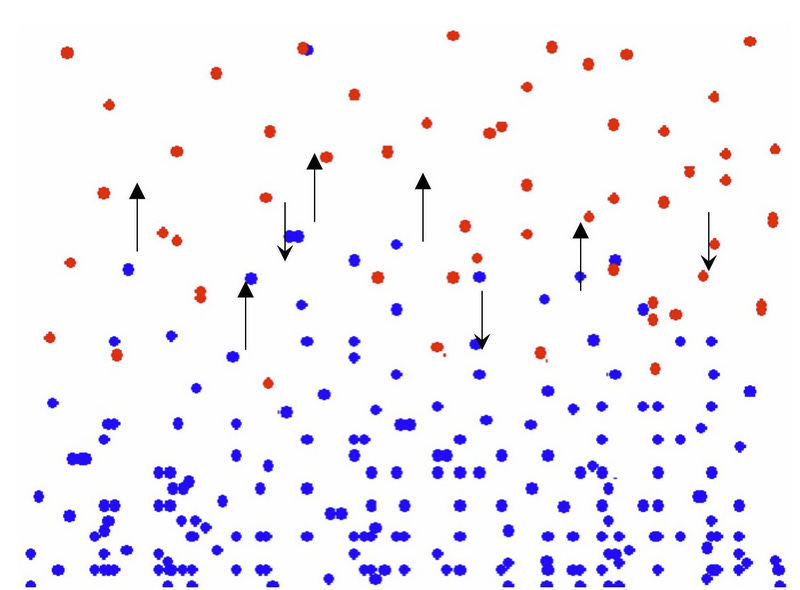
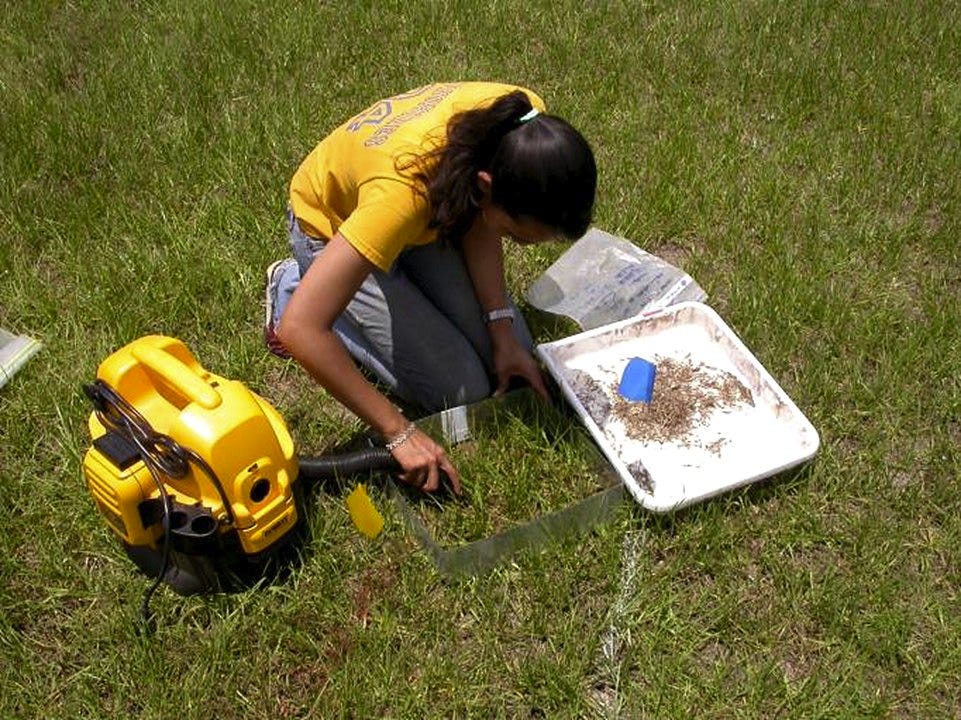
Thanks for this fascinating view into a world totally unknown to me.
Steve
This reminds me of a podcast from Radiolab I listened to recently (see link below) about Argentine ants. They are apparently a very "pure" type of ant that doesn't assimilate with other types of ants, and are very aggressive towards others. The podcast describes the test tube "fighting" test you use above, with ants 600 miles away from each other "recognizing" each other and not fighting. It was an interesting episode and reminded me of you, Walter.
Thank you for your interesting-as-always insights!
https://radiolab.org/podcast/226696-argentine-ant-invasion